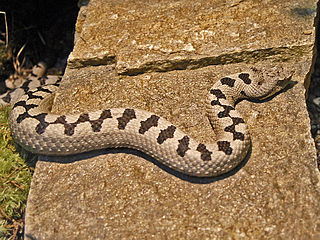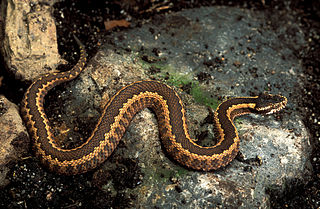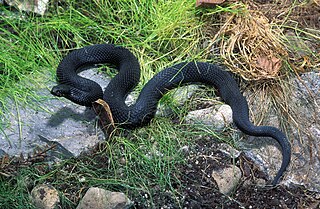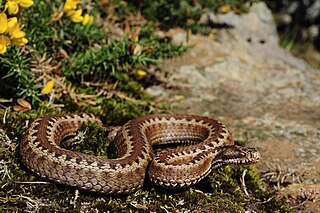
Macrovipera, known as the large Palearctic vipers, is a genus of vipers that inhabit the semideserts and steppes of North Africa, the Near and Middle East, and the Milos Archipelago in the Aegean Sea. Like all other vipers, they are venomous. These snakes are responsible for a number of bites in Africa and Western Asia every year. They have a reputation for being ill-tempered and can inject a lot of venom, which is why they should be considered as very dangerous. Two species are currently recognized.

Vipera is a genus of vipers. It has a very wide range, being found from North Africa to just within the Arctic Circle and from Great Britain to Pacific Asia. The Latin name vīpera is possibly derived from the Latin words vivus and pario, meaning "alive" and "bear" or "bring forth"; likely a reference to the fact that most vipers bear live young. Currently, 21 species are recognized. Like all other vipers, the members of this genus are venomous.
Vipera berus bosniensis, the Balkan cross adder or Bosnian viper, is a venomous viper subspecies endemic to the Balkan Peninsula.

Cerastes vipera, common names Sahara sand viper and Avicenna viper, is a viper species endemic to the deserts of North Africa and the Sinai Peninsula. No subspecies are currently recognized. Like all other vipers, it is venomous.
Macrovipera lebetinus transmediterranea is a viper subspecies endemic to North Africa. Like all other vipers, it is venomous.
Vipera ammodytes montandoni is a venomous viper subspecies endemic to Bulgaria and southern Romania.

Vipera transcaucasiana is a venomous viper species endemic to parts of Georgia and northern Turkish Anatolia.

Vipera aspis atra is a venomous viper subspecies endemic to France, Switzerland and Italy.

Vipera aspis francisciredi is a venomous viper subspecies endemic to northern and central Italy and adjacent Croatia, Slovenia, and Switzerland.
Vipera aspis hugyi is a venomous viper subspecies endemic to southern Italy.
Vipera berus sachalinensis is a viper subspecies endemic to Asia. Like all other vipers, it is venomous.

The Mount Bulgar viper, also called the Bulgardagh viper is a viper species endemic to the mountains of southern Turkey. Like all other vipers, it is venomous. No subspecies are currently recognized.

Vipera dinniki is a viper species native to the Caucasus Mountains region, part of Russia, Georgia, and Azerbaijan. Like all other vipers, it is venomous. No subspecies are currently recognized.

Vipera latastei, known as Lataste's viper, the snub-nosed viper, and the snub-nosed adder, is a species of venomous snake in the subfamily Viperinae of the family Viperidae. The species is endemic to the Iberian Peninsula and northwestern Maghreb. Three extant subspecies and one extinct subspecies are currently recognized, including the nominate subspecies described here.

Vipera lotievi, commonly known as the Caucasian meadow viper, is a species of venomous snake in the family Viperidae. The species is endemic to Azerbaijan, Georgia, and Russia. There are no subspecies that are recognized as being valid.

Vipera monticola, also known as the Atlas mountain viper, is a viper species endemic to Morocco. Like all other vipers, it is venomous.

Vipera nikolskii is a venomous viper species endemic to Ukraine, eastern Romania, and southwestern Russia. No subspecies are currently recognized.

Vipera seoanei is a venomous viper species endemic to extreme southwestern France and the northern regions of Spain and Portugal. Two subspecies are currently recognized, including the nominate race described here.
Vipera seoanei cantabrica is a venomous viper subspecies endemic to the Cantabrian Mountains in Spain.













